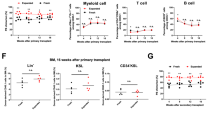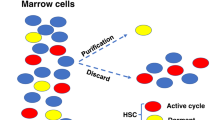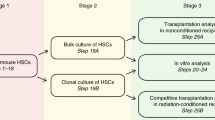Abstract
LONG-TERM reconstitution of the lymphohaematopoietic cells of a mouse after lethal irradiation requires the transplantation of at least (5–10) × 103 bone marrow cells1,2. Several cell-separation techniques based on cell-surface characteristics have been used in attempts to identify the pluripotent haematopoietic stem cells (PHSC), and have allowed the long-term engraftment of lethally irradiated mice with an enriched fraction of fewer than 200 marrow cells3–5. But these techniques enrich not only for PHSC but also for haematopoietic progenitors, especially day-12 spleen colony-forming units (CFU-S)3–5. Although day-12 CFU-S have been postulated to be primitive multipotential haematopoietic progenitors, with day-8 CFU-S representing later, more committed progenitors6, recent evidence suggests that neither of these CFU-S represents mouse PHSC7–9. Here we report that counterflow cen-trifugal elutriation, which sorts cells on the basis of size and density, can separate PHSC from these less primitive progenitors. The fraction containing the largest cells was enriched for the granulocyte-macrophage colony-forming units (CFU-GM), but gave only transient, early engraftment and was therefore depleted of PHSC. The intermediate fraction was enriched for CFU-S, but depleted of CFU-GM. Despite being devoid of CFU-GM and CFU-S, the fraction consisting of only morphological lymphocytes gave sustained, albeit delayed, reconstitution of all lympho-haematopoietic cells, and was therefore enriched for PHSC. We conclude that there are two vital classes of engrafting cells: committed progenitors, which provide initial, unsustained engraftment, and PHSC, which produce delayed, but durable, engraft-ment. Therefore for late haematological reconstitution, PHSC must be transplanted with a distinguishable source of early engraft-ing cells, thereby allowing the lethally irradiated host to survive initial aplasia.
This is a preview of subscription content, access via your institution
Access options
Subscribe to this journal
Receive 51 print issues and online access
$199.00 per year
only $3.90 per issue
Buy this article
- Purchase on Springer Link
- Instant access to full article PDF
Prices may be subject to local taxes which are calculated during checkout
Similar content being viewed by others
References
Jones, R. J. et al. Blood 70, 1186–1192 (1987).
Boggs, D. R., Boggs, S. S., Saxe, D. F., Gress, L. A. & Canfield, D. R. J. clin. Invest. 70, 242–253 (1982).
Sprangrude, G. J., Heimfeld, S. & Weissman, I. L. Science 241, 58–62 (1988).
Visser, J. M. W., Bauman, J. G. J., Mulder, A. H., Eliason, J. F. & de Leeuw, A. M. J. exp. Med. 59, 1576–1590 (1984).
Szilvassy, S. J., Lansdorp, P. M., Humphries, R. K., Eaves, A. C. & Eaves, C. J. Blood 74, 930–939 (1989).
Magli, M. C., Iscove, N. N. & Odartchenko, N. Nature 295, 527–529 (1982).
Jones, R. J., Celano, P., Sharkis, S. J. & Sensenbrenner, L. L. Blood 73, 397–401 (1989).
Ploemacher, R. E. & Brans, R. H. C. Expl Hematol. 17, 263–266 (1989).
Bertoncello, I., Hodgson, G. S. & Bradley, T. R. Expl Hematol. 16, 245–249 (1988).
Schwartz, G. N., MacVittie, T. J., Monroy, R. L. & Vigneulle, R. M. Expl Hematol. 14, 963–970 (1986).
Wagner, J. E. et al. Blood 72, 1168–1176 (1988).
Martin, P. J. et al. Blood 66, 664–672 (1985).
Mitsuyasu, R. T. et al. Ann. intern. Med. 105, 20–26 (1986).
Bennett, M. & Cudkowicz, G. J. cell. Physiol. 72, 129 (1968).
van Bekkum, D. W., van Noord, M. J., Maat, B. & Dicke, K. A. Blood 38, 547–558 (1971).
Andrews, R. G., Singer, J. W. & Bernstein, I. D. J. exp. Med 169, 1721–1731 (1989).
Sutherland, H. J., Eaves, C. J., Eaves, A. C., Dragowska, W. & Lansdorp, P. M. Blood 74, 1563–1570 (1989).
Lamar, E. E. & Palmer, E. Cell 37, 171–177 (1984).
Mauch, P. & Hellman, S. Blood 74, 872–875 (1989).
Engleman, E. G., Benike, C. J., Grument, F. C. & Evans, R. L. J. Immun. 127, 2124–2128 (1981).
Coffman, R. L. & Weissman, I. L. Nature 298, 681–683 (1981).
Gross-Bellard, M., Dudet, P. & Chambon, P. Eur. J. Biochem. 36, 32–38 (1973).
Lemischka, I. R., Raulet, D. H. & Mulligan, R. C. Cell 45, 917–927 (1986).
Author information
Authors and Affiliations
Rights and permissions
About this article
Cite this article
Jones, R., Wagner, J., Celano, P. et al. Separation of pluripotent haematopoietic stem cells from spleen colony-forming cells. Nature 347, 188–189 (1990). https://doi.org/10.1038/347188a0
Received:
Accepted:
Issue Date:
DOI: https://doi.org/10.1038/347188a0
This article is cited by
-
The “Mystery Cell Population” Residing in Murine Bone Marrow – A Missing Link Between Very Small Embryonic Like Stem Cells and Hematopoietic Stem Cells?
Stem Cell Reviews and Reports (2023)
-
Impact of Age, Sex, and Genetic Diversity in Murine Models of the Hematopoietic Acute Radiation Syndrome (H-ARS) and the Delayed Effects of Acute Radiation Exposure (DEARE)
Current Stem Cell Reports (2022)
-
Small hypoxia-primed mesenchymal stem cells attenuate graft-versus-host disease
Leukemia (2018)
-
Very small embryonic-like stem cells (VSELs) represent a real challenge in stem cell biology: recent pros and cons in the midst of a lively debate
Leukemia (2014)
-
Very small embryonic-like stem-cell optimization of isolation protocols: an update of molecular signatures and a review of current in vivo applications
Experimental & Molecular Medicine (2013)
Comments
By submitting a comment you agree to abide by our Terms and Community Guidelines. If you find something abusive or that does not comply with our terms or guidelines please flag it as inappropriate.



